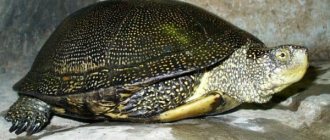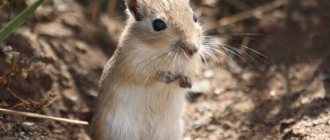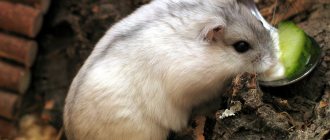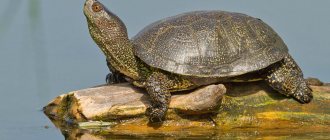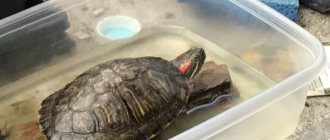Also on topic:
REPTIENTS
This group appeared in the Triassic ca. 200 million years ago. It is possible that turtles descended directly from cotylosaurs, the most primitive reptiles. Although there are few fossils to support this hypothesis, the extinct genus Eunotosaurus is a good candidate for being an evolutionary link. This animal had a flattened body and greatly expanded ribs.
Unlike their snake relatives, turtles were rarely worshiped and were never particularly feared. Indeed, they pose virtually no danger to human life. Unless a swimmer gets too close to a male leatherback turtle (Dermochelys coriacea) can be grabbed by its strong flippers and drowned. The fact is that in a state of strong sexual arousal, he is able to mistake any large object for a female.
Also on topic:
SYSTEMATICS OF ANIMALS
Anatomy.
The torso of turtles is enclosed in a shell, which also partially protects the head, neck and limbs. Its upper part, or carapace, covers the back and sides of the reptile, the lower, or plastron, covers the stomach. The shell is so strong that it can withstand 200 times the weight of the owner.
Typically, the inner layer of the shell is bone, and the outer layer is formed by hard horny tissue. Both layers consist of many elements tightly fitted to each other. The bone elements are called plates, and the horny ones are called scutes. The greater strength of the shell is partly ensured by the fact that the boundaries between the internal plates and the outer scutes do not coincide.
As the turtle increases in size, horny substance grows along the edges of each scute. If growth is interrupted by periods of hibernation, growth rings are clearly visible on the scutes, allowing one to estimate the age of the individual.
The ribs are fused to the shell, so the chest is motionless. As a result, the turtle's breathing resembles the diaphragmatic breathing characteristic of humans and other mammals. Special muscles pull the internal organs back, allowing the lungs to fill with air; then other muscles carry out the reverse process, compressing the lungs. Some aquatic species are not completely dependent on pulmonary respiration and are able to absorb oxygen also through the mucous membrane of the pharynx.
Differences between males and females (sexual dimorphism) are expressed differently depending on the species; sometimes they are completely invisible. A comparison of males and females of other species shows that the former have a longer and thicker tail, and the anus is located further from its base. This dimorphism is especially pronounced in huge sea turtles. Other sex differences concern the shape of the plastron, the color and size of the head, and the overall dimensions of the body.
Bighead
A freshwater turtle whose shell length does not exceed 20 cm. It is called “ big-headed ” because of the size of the head, which is disproportionately large. Due to its size, it does not retract into the shell.
She has a movable neck and a very long tail. It is common in Vietnam, China, Thailand, etc., and chooses clear and fast streams and rivers with a rocky bottom to live.
During the day, the big-headed turtle prefers to lie in the sun or hide under stones, and at dusk it begins to hunt. She can swim quickly, deftly climb rocky rapids and banks, and can even climb an inclined tree trunk. In Asia they were eaten, so their numbers there sharply decreased.
Mating and egg laying.
Mating behavior begins with courtship, the forms of which are species specific. The male may butt and push the female while gently biting her. In large turtles, courtship is sometimes accompanied by loud grunting. Male painted turtles (Chrysemys picta) and ornamented turtles (Pseudemys) demonstrate affection in a special way: swimming backwards and dragging the female with them, they stroke or pat her on the face with the long claws of their front paws.
Mating can take place on land or in water. In this case, the penis, hidden at the base of the tail in a calm state, extends through the opening of the cloaca. Females of some turtle species can store viable sperm for a long time (this is also true of some other vertebrates), and one mating allows them to lay fertilized eggs over the next several years. However, their number decreases every year until a new portion of sperm is obtained.
Turtle eggs are oval or round, white or almost white. Females bury them in the ground to a depth not exceeding the length of their hind legs, or hide them in a pile of rotting plants. Most often these are well-lit places. Usually there is one clutch per year, but some sea turtles have as many as seven clutches in one breeding season. Depending on the type, eggs in a clutch range from one to 200.
Painted
Its other name is decorated turtle . It received this name because of its attractive colors. The painted turtle is the most common species in North America, where they can be found in freshwater bodies.
The length of an adult female is from 10 to 25 cm, males are slightly smaller. She has black or olive skin and has orange, yellow and red stripes on her limbs. There are several subspecies of the painted turtle. In the early 1990s, this species was the second most popular turtle kept in the home.
Their numbers could be reduced, because... Their habitat is being destroyed, many die on highways, but due to the fact that turtles easily get along with people, it has helped them maintain their numbers.
They feed on insects, fish, and crustaceans. Thanks to their strong shell, they have almost no enemies, except raccoons and alligators. But the eggs of these turtles are often eaten by snakes, rodents and dogs. In winter, painted turtles sleep by burying themselves in the mud at the bottom of reservoirs.
Hatching.
The period of incubation and hatching is the most dangerous in the life of turtles; at this time, numerous enemies feast on their delicious eggs and still soft-bodied cubs. Mammals dig up clutches, and seabirds grab newly hatched turtles as they rush along the shore to the water. Once in the water, the babies become prey for voracious fish. At this time, a large number of lovers of their eggs and young usually accumulate near the breeding grounds of turtles. Depending on the species, it takes different times for the shell to harden, but usually at least several months. After this, the turtles become relatively inaccessible to predators.
In nature, turtles grow quickly. There is a known example when, even in captivity, Galapagos elephant tortoises (Geochelone elephantopus), starting from about 11 kg, annually gained the same amount until they weighed more than 100 kg. Many small species reach sexual maturity between the ages of 2 and 11 years.
How do they reproduce?
The age of puberty depends on the size of the individuals. The smallest reptiles are ready to reproduce at 2 years of age; giant reptiles mature at 10-12 years and later. Regardless of the species and habitat conditions, turtle reproduction has several common features:
- during the mating season, skirmishes occur between males, during which rivals try to turn each other over or bite each other with a strong beak;
- before mating, males court females by stroking them with their forelimbs and making primitive sounds;
- all turtles are oviparous animals, the formation of eggs after fertilization occurs within 2-3 months, some females are able to retain the sex cells of the male in the body and make several repeated clutches per season;
- females choose places for laying so that the eggs warm up under the sun's rays; they dig holes for laying eggs themselves or use crocodile ones;
- The sex of the cubs is determined during the developmental stage and depends on temperature.
All turtles, with the exception of a few species, do not return to them after laying eggs and do not take part in protecting and raising their offspring. Turtles are born after 2-3 months; in larger species, the incubation process lasts up to six months. The hatched babies crawl towards the water. Many of them die, becoming food for birds of prey and animals.
Lifespan.
No known vertebrate lives as long as turtles. Most of the information suggesting that their lifespan is slightly more than 50 years refers to individuals kept in captivity. Some species certainly live much longer. The Carolina box turtle (Terrapene carolina) found in Rhode Island was almost certainly 130 years old. The maximum period is considered to be approx. 150 years, but it is quite possible that the actual life expectancy of individual individuals is much longer.
Nutrition.
Turtles in general can be called omnivores, although some species prefer plant food, others animal food, and still others eat everything. A strictly specialized diet is rare. Some aquatic turtles only feed underwater. Very young individuals require daily feeding, but this is not necessary for adults. In fact, once well fed, they can go months, and possibly years, without food.
Turtles have no teeth, and the sharp edges of their jaws are capable of biting food, but not chewing it. Tough, fibrous plants are difficult for turtles to handle, and animal meat sometimes has to be torn into pieces using the claws on the front paws. Some species have horny ridges inside the mouth, which allow them to crush prey protected by hard coverings.
Economic importance
Not too large land and aquatic turtles are popular pets that are highly valued by exotic lovers . Turtle meat is widely used for food purposes and is consumed raw, boiled or fried, and the unpretentiousness of such animals makes it easier to transport live reptiles as “live canned food.” The animal's shell is used in the manufacture of such traditional women's hair ornaments as kanzashi.
Most American states allow, but discourage, pets such as turtles, but Oregon does not allow such pets. It should also be noted that federal law in America completely prohibits the trade or transportation of turtles whose size is less than 100 mm, and in the western part of the country turtle racing, which is an original fair entertainment, is very popular.
Unlike many other well-known and studied reptiles, any turtle poses virtually no real threat to human life and health. The exception is represented by male leatherback turtles, who, with the onset of mating season, are able to grab swimmers with flippers or drown them, and biting and aggressive snapping turtles can inflict a serious bite on a person.
Video
Sense organs and higher nervous activity.
Turtles are good at distinguishing odors at close range and, judging by some observations, use their sense of smell when choosing food. Vision is also well developed: these animals can be taught to recognize contours and colors. Both the shell and scaly skin have tactile sensitivity, and the giant tortoise even feels the pressure of a straw that is passed along its massive carapace. Although it has long been known that turtles are sensitive to vibrations transmitted through the soil, their ability to perceive airborne sound waves has long been controversial. Today the existence of at least weak “ordinary” hearing in them is considered proven.
Compared to other reptiles, turtles are very smart. They easily learn to follow their owner, seem to enjoy the attention they receive, and get used to a certain routine well. Apparently, some individuals are smarter than others. For example, among six Agassi gophers (Gopherus agassizi) living together, one individual, of its own volition, climbed up an inclined plane onto a platform and slid down the other side down a metal chute. She obviously enjoyed this activity and repeated it for hours on end. But in some situations, turtles are surprisingly slow-witted. For example, they may spend a lot of energy climbing over an obstacle that is not difficult to get around; or for a long time they try to squeeze through a gap that is much smaller in size.
Care
Proper nutrition
: for a land turtle, the most basic food is plant matter. But it should also be varied, so it is better to make a green mixture. Suitable for her: grass - dandelion, plantain and clover and coltsfoot. In smaller proportions: vegetables - carrots and cabbage, fruits - apples and bananas, strawberries.
Very rarely you can give a piece of boiled egg, rolled oats with water, or lean meat. All food must be chopped. Don’t forget to buy special food for turtles, they contain vitamins and minerals. You need to feed once a day
, and
for adults – once every two days
.
Water treatments
: Even though you have made a pool, your pet needs to be washed.
They do this once a week. Pour some warm water into a basin; it would be nice to add chamomile. If your pet is very dirty, you can use a soft sponge with a small amount of soap. The entire procedure should take no more than 30 minutes. Then wipe with a towel. Turtles have molting – changing the upper shell plates
. During this period, bathing should be done with baking soda added to the water.
Communication with people
: A turtle is a peaceful pet, but you can’t often pick it up, especially for small ones. Constantly tugging at a turtle can cause it to become stressed, which can lead to slower activity and illness.
Free range
: In the summer, it is worth taking the enclosure outside or making it a separate one for the outdoors. In good weather, you can leave the turtle overnight. Make sure your pet doesn't escape and there's no threat from other animals!
Cheloniidae
(sea turtles). Five or six species of the family are large reptiles with limbs resembling oars or flippers. These are exclusively aquatic animals, coming ashore only to lay eggs or bask in the sun. It is very difficult for them to move on land. At least one species is found in all warm oceans.
The green (soup) turtle (Chelonia mydas) is the most famous of the sea turtles. It is distributed throughout the globe, and it is from it that the famous turtle soup is prepared. Previously, these reptiles were essentially mercilessly exterminated, often killing the females just before laying eggs.
Keeping at home
Keeping turtles at home has recently become very popular, both land and aquatic turtles are kept. And why not, because caring for them is extremely simple, and turtles themselves are unpretentious creatures. True, all of the above is true for small turtles, since keeping large turtles in the house will not be entirely appropriate.
So, what are the rules for caring for turtles? First, in the turtle's habitat, you need to keep a thermometer to monitor the air temperature and a thermometer to monitor the water temperature (if it is an aquatic turtle in an aquarium).
The water in an aquarium for turtles must either be purified using filters, or if there are none, then changed every day. Maintaining hygiene for aquatic turtles involves removing algae from their shells. But land turtles need to be bathed daily in warm water, washing away dirt and food debris. Also, in winter, it is advisable to irradiate turtles a little with the rays of a quartz lamp, thus creating a kind of sunbathing.
Dermochelyidae
(leatherback turtles). The leatherback turtle (Dermochelys coriacea) is the only living species of this family. This giant can reach a mass of more than 680 kg with a front flipper span of 3.6 m. The leathery shell bears 7 longitudinal ridges on the dorsal side and 5 on the ventral side. Although the range of these turtles covers all warm oceans, they are the rarest among the widespread marine species of the order. The question of the systematic position of the group remains controversial. It was allocated to a special suborder Athecae (scutellae), but most experts agree only on the rank of superfamily.
Tuberous
Its other name is terrapin . This is a species of freshwater turtle that lives in the salt marshes of the United States, in the coastal area. The lump turtle is gray, but can also have brown, white or yellow skin, covered with a gray or brown shell. Its diameter is 19 cm in the female and 13 cm in the male, but larger specimens are also occasionally found.
Body length is from 18 to 22 cm in females, and 13-14 cm in males. They weigh about 250-350 g. These turtles eat crabs, shellfish, small fish, and occasionally indulge in marsh vegetation.
They themselves suffer from attacks by raccoons, skunks and even crows. Local residents also love their meat, so this species is bred on farms. They were once the main food of European settlers, and in the 19th century they became a delicacy. In nature they can live up to 40 years.
Trionychidae
(three-clawed). These turtles are easily recognized by their soft, leathery shell without any scutes. They have a flat body, an elongated conical snout and legs with webbed swimmers. These are one of the fastest turtles, moving quickly both in water and on land. The long neck allows it to grab food and bite the enemy painfully, even if they are at a considerable distance. The claws of large individuals can leave deep scratches. Representatives of certain species tolerate captivity well, living in it for up to 20 years or more (the record is 25). Some three-clawed turtles are highly prized for their tasty meat. The largest of their 20 species, the large soft-shelled turtle (Pelochelys bibroni) lives in Southeast Asia; its shell reaches a length of more than 1.2 m. Representatives of this family live in North America, Africa, Southeast Asia, the Malay Archipelago and New Guinea. Three species are found in the United States.
Types of turtles
The long stay of representatives of this order on the planet allowed them to divide into 328 species, differing in external characteristics, size, habitat, nutrition and lifestyle.
The classification involves the division of reptiles, depending on how they hide their heads in the shell, into cryptonecks and side-necks. The first group presses their head into the shell by contracting the neck muscles. The second is folded to the side, under one of the front paws.
Another classification is based on the habitat of these reptiles:
- sea turtle - lives in the salty waters of the seas and oceans;
- terrestrial - capable of living both on the surface of the earth and in fresh waters; this variety, in turn, is divided into freshwater and land.
Green turtle
This sea turtle chose the waters of the Atlantic, Pacific and even Indian oceans for its life.
There are two subspecies of these reptiles: Atlantic and eastern Pacific. Its elongated shell can be not only green, but also dark brown with yellow and white stripes or spots.
Reptiles got their name not from their external coloring, but from the color of the meat they ate.
The green turtle is one of the largest species. The length of its shell can reach up to 2 m, and its weight can reach 400 kg.
Young individuals live exclusively in water, where they feed on small fish, mollusks, and jellyfish. Adult reptiles come ashore, where they begin to feed on plant foods, which over time become their main diet.
The tasty meat of these animals was traditionally used for food (they are even called soup animals), which led to a decline in the population. Hunting them is currently prohibited in many countries.
The onset of puberty occurs after 10 years, sometimes much later. Reptiles mate in water, but lay their clutches on the shore, in the same places where their predecessors laid eggs. They dig very large holes in which they place up to 200 eggs. Small turtles, hatching, run towards the water. If they managed to get there, they will spend many years in the ocean, until the moment comes when they themselves have to go ashore to give birth.
If your pet is a sea turtle, keep in mind that caring for it at home is much more difficult than for land-based ones, since you need to have spacious aquariums with water adapted for the reptile.
Far Eastern turtle
Another name for this species is Chinese trionix, or Chinese tortoise. The Far Eastern turtle prefers to live on the silt-covered bottom of large lakes and rivers with gently sloping overgrown banks. Their habitat is Primorye, the southern part of the Amur in Russia, Vietnam, China, Japan, Korea and Taiwan.
The Far Eastern turtle is green-brown or green-gray in color with pale yellowish spots. Its usual size is about 30 cm, but there have been specimens up to 40 cm and weighing more than 4 kilograms. They have fleshy lips covering strong jaws.
The shell of these animals in young individuals has a rounded shape. It becomes flatter with age. A distinctive feature of young individuals is their bright orange abdomen, the color of which becomes pale over time.
The Chinese turtle is capable of hunting both in water and on land, where it goes out to bask in the sun. These reptiles hibernate by burying themselves in the mud.
The diet of these predatory reptiles consists of fish, shellfish, amphibians and insects. The Far Eastern turtle can guard its prey for a long time by burying itself in the mud.
At the age of 6-7 years, the Far Eastern tortoise becomes sexually mature. Usually in July they lay eggs at a short distance from the water. During the season, the female makes several clutches, from which about 70 turtles emerge. After 1.5 - 2 months, babies appear, the size of which is no more than 3 cm. They quickly run to the water and hide for a long time in coastal vegetation and between stones.
The Far Eastern tortoise has a fairly aggressive character and can strongly bite its attacker.
If this turtle lives in a house from an early age, it easily gets used to a person and can even feed from his hands.
Central Asian tortoise
Living in the southeast of Eurasia, this steppe tortoise loves wet areas in river valleys, foothills, agricultural lands, sandy and clay semi-deserts. Animals dig holes or occupy empty ones.
Observations shed light on how many years this turtle lives. It turns out that life expectancy depends on its activity. At home in a closed terrarium, it is unlikely to overcome the 15-year mark, when in the wild it can live for 30 years. Not in a natural environment, the Central Asian tortoise, even if care and nutrition are as close as possible to natural ones, lives much shorter.
The Central Asian tortoise does not grow more than 20 cm, while males are slightly smaller in size than females.
This steppe turtle hibernates quite early: at the beginning of summer, immediately after laying eggs. This is due to the fact that this particular time in their habitat is the driest. Lack of food in sufficient quantities forces them to wait out in a state of sleep.
The Central Asian turtle has a very beautiful shell - reddish-olive with dark round spots.
European tortoise (marsh)
Reptiles of this species are dark brown, dark olive, almost black in color with small yellow streaks or spots. A distinctive feature is a very long tail and the absence of a beak.
The habitat of these animals is unusually wide: they can be found in the European part of Russia, the Caucasus, Bashkiria, Kazakhstan, Turkmenistan and even in northwest Africa. They prefer forest, forest-steppe and steppe areas, the banks of slow-flowing rivers, and wetlands.
These reptiles are found in mountainous areas at altitudes of up to 1500 meters above sea level.
It is impossible to say that the European is an aquatic turtle. She prefers to get out onto land quite often and moves relatively quickly along it.
The diet of representatives of this species is unusually wide: it eats worms, mollusks, small reptiles, fish, and chicks of waterfowl. She does not disdain carrion.
Depending on the region, they become sexually mature at the age of 5-9 years. Eggs are laid near water bodies. The sex of the offspring depends on temperature. When the levels are high, females are born, while when they are low, males are born.
Unfortunately, the clutches are attacked by predators (foxes, raccoons, otters, crows), who are happy to feast on both the eggs themselves and the small turtles.
Giant turtle
Another name for these reptiles is directly related to their habitat - the Seychelles giant tortoise. This terrestrial animal is endemic to Aldabra Island.
The size of the shell of this large animal reaches a meter. It flaunts clearly defined shell segments, has fairly large legs that help it move on land, and a relatively small head.
Given its size, the reptile is a herbivore. Everything a turtle eats grows around it. She happily eats all low-growing bushes and grass.
There are currently only 150,000 left in the wild, so the reptile is protected. On the island where they live, not only hunting, but also any economic activity is prohibited.
Reptiles lay eggs from May to September, and they are able to regulate the population size: if there was not enough food, their clutches will contain only 5-6 eggs.
Galapagos tortoise (elephant)
He is the largest representative of his squad. These reptiles live only on the Galapagos Islands and are not found anywhere else. Their weight sometimes exceeds 400 kg, and the length of the shell reaches 2 m. They have fairly muscular paws, which have sharp claws (5 on the front and 4 on the hind). In case of danger, they pull their head and limbs into the shell.
At the end of the 20th century, the population of these animals decreased to 3,000 individuals, which became critical, so a decision was made to protect the reptiles.
Currently, there are two varieties of these reptiles, differing in habitat (relatively small individuals live in arid areas), size, color and shape of the shell.
Scientists actively studying the life of Galapagos endemics have identified interesting facts about turtles of this species: for example, the fact that they can eat poisonous plants that no other animal eats. In some cases, they are able to live for several months without food or fresh water.
Mating and laying of eggs of these giants occurs at any time of the year, but peaks of activity occur in certain seasons.
water turtle
This reptile is also called the red-eared or yellow-bellied. The water turtle received its original names solely for the bright accents in its color: there is a red spot on its head, and its abdomen is yellow.
There are 15 subspecies of these reptiles belonging to the American freshwater family.
The size of the animal depends on the subspecies and gender - from 18 to 30 cm, with males slightly smaller than females.
Its main habitat is America, but its presence is also noted in Europe (Spain and England), northern Africa, and Australia. For their life, they choose swampy areas with low banks, since this river turtle loves to get ashore and bask in the sun.
In Australia, the water turtle is considered a pest and its numbers are controlled.
The water turtle lays its eggs on land, where it digs out a spherical nest and places up to 20 eggs there. Reptiles of this species do not care about their offspring.
The water turtle feeds on insects, small fish, and worms. She chews her food with her head completely immersed in the water. If you have a water turtle living in your home, care and feeding should be consistent with its natural needs.
We have long found out how many years a turtle lives at home. If the maintenance and care are natural, it can easily live for half a century. In nature, this age is somewhat less.
One of the subspecies is the yellow-eared turtle. As the name suggests, its main decoration is the bright color of the shell and the yellow spot in the area of the auricle.
The yellow-eared turtle differs from its red-eared counterparts only in color. Their habitat, diet and reproduction are identical.
The yellow-eared turtle thrives at home. Maintenance and care do not require much time and do not cause much trouble for the owners.
Musk turtle
Small in size (the maximum length of the shell is no more than 13.5 cm), the reptile has chosen the American continents.
Its dirty-brown shell has three longitudinal ridges, and light stripes are visible on its head.
It lives in small rivers with silted banks, where this river turtle hunts and lays eggs.
When the water temperature drops below 10 degrees, the reptile begins to dig a hole for hibernation. Unlike many species, muskies can sleep in groups. The period of sleep itself depends not on the season, but on the temperature: in the southern regions, where there are no low temperatures, this reptile is active throughout the year and does not hibernate.
If you have a musk turtle in your home, keeping it alone is not advisable. It is better to have several individuals at once. This will affect how many years the turtle lives at home.
The musk turtle is quite common in home aquariums; keeping, feeding and caring for it does not require much effort.
Where do turtles live? Habitat
Reptiles of this order live on almost all continents of the world. The only exceptions are Antarctica and desert areas, the climate of which is completely unsuitable for these animals. Any coast - be it the oceans or small rivers and lakes - can boast of its own view, or even more than one.
They find food almost everywhere: it can be insects, worms, small fish, crustaceans and vegetation. Its unpretentiousness in food makes the reptile able to survive in almost any place.
Even in reservoirs located in large cities, you can find these animals. They go ashore to bask in the sun. During the breeding season, you can come across clutches of their eggs on deserted beaches.
Turtle at home
A turtle is a reptile that has long settled in homes, becoming a favorite pet. Home care for this reptile is insignificant, so many people choose them for their home.
How many years a turtle lives at home, first of all, depends on the species, age of the animal that comes to you, and the conditions in which it will live. Comfortable existence and feeding as close as possible to natural habitat conditions will allow your pet to live long enough. If the turtle feels good in the house, and the maintenance and care are appropriate, then it can live up to 50 years.
Which turtle is best for a home?
Usually river reptiles become pets. A river turtle, once at home, adapts quite quickly. Its maintenance does not require an overly spacious aquarium, but it is very important to equip it correctly, creating a swimming area and dry land for your pet to go to when necessary.
Suitable for keeping in the house:
- water (red-eared and yellow-eared);
- European (swamp);
- Central Asian (steppe);
- Far Eastern;
- musk turtle.
Keeping sea turtles in home aquariums is very problematic. Even young individuals require special water, reminiscent of ocean water. And for older ones, very spacious tanks are needed, since in limited spaces the animal will not be able to be active enough, and this also determines how many years a turtle lives at home.
Before purchasing an animal, get acquainted with useful information about it. Temperature, nutrition and care, activity and the ability to live alone or in pairs are very important for the reptile.
Pelomedusidae, Chelidae
(suborder side-necked turtles: pelomedus and snake-necked). Representatives of these two families differ in the way the neck bends when the head is pulled under the edge of the shell: if in other turtles the neck bends in a vertical plane, then in them it bends in a horizontal plane, which is explained by the special structure of the spine. Side-necks live in the Southern Hemisphere or the regions closest to it and are not found in North America, Europe and Asia. Both families unite approx. 50 types. The most bizarre of all turtles, the matamata (Chelus fimbriata) from South America, is a snake-necked turtle. Her head is covered with many outgrowths sticking out in different directions. The Australian snake-necked turtle (Chelodina longicollis) has a thin neck almost as long as its shell.
Enemies in nature
Speaking of enemies, in natural conditions the main enemies of a turtle are some birds of prey (eagles,
hawks), which grab small turtles, lift them to a great height, from there they throw them onto stones and peck out their entrails from their broken shells.
Interesting fact: the great ancient Greek playwright Aeschylus died an extremely ridiculous death, he was killed by a turtle that fell on his head. The eagle, having lifted the turtle to a height, mistakenly considered the playwright's bald head to be a large stone suitable for breaking the turtle's shell.
Death of Aeschylus by an eagle and a turtle.
As for giant turtles, given their weight and size, they have no enemies in nature. Even people are increasingly treating these majestic, long-lived creatures with due respect.
Chelydridae
(snapping turtles). The family includes only 2 species, of which the best known is the snapping turtle (Chelydra serpentina). It is an aquatic reptile native to much of North America and northwestern South America, abundant in southeastern Canada and the eastern half of the United States, where it is highly prized as a food item. Snapping turtles are unfairly blamed for killing large numbers of fish and waterfowl. The weight of these animals often reaches 13.6 kg. When pulled out of the water, they can bite painfully.
Another species, the snapping turtle (Macrochelys temmincki) is one of the giants of the order, reaching a mass of approx. 90 kg. Not only are they the heaviest of its freshwater species, but they are also the most water-bound of the North American turtles. They are found in the southeastern United States, mainly in the lower Mississippi. Being slow, the snapping turtle lures prey with the help of a fleshy outgrowth of the bottom of the mouth, which moves in its open mouth like a worm.
Does a turtle have teeth
The oral cavity of turtles of all varieties is structured almost the same: biting and grinding food is carried out with the help of rhamphothecae. These are reduced teeth that have taken the form of horny sheaths covering the edges of the jaws. On the surface of the rhamphothecae there are irregularities and roughness, which crush solid food. Thanks to the horny plates, the turtle's mouth resembles a beak. This structure of the oral cavity is also characteristic of some other orders of reptiles.
JELLYFISH
Kinosternidae
(mud turtles). Turtles of this family, which includes 21 species, usually live at the bottom of rivers and lakes. The group's range extends from southeastern Canada through the central and eastern United States to South America. The eight species of mud turtles found in the United States have small, fleshy “whiskers” on their chins that help distinguish them from other members of the order.
The most famous member of the family, the common musk turtle (Sternotherus odoratus), is common in the waters of the eastern United States. Its length does not exceed 13 cm, but it greatly annoys local fishermen, as it often gets hooked, and when it is picked up, it secretes a stinking secretion from the musk glands. In addition, she is warlike and bites painfully.
Trailing turtles (genus Kinosternon) are found almost exclusively in the southeastern United States. They avoid deep bodies of water and come to land from time to time. The range of the Pennsylvania turtle (Kinosternon subrubrum) extends from the southeast of the country along the Atlantic coast to the southwestern tip of Connecticut.
Interesting facts about turtles
- The smallest turtle in the world is the Cape flat turtle. It lives in the south of the African continent. The length of the shell of adult individuals does not exceed 9-10 cm. The average weight of the animal is 240 grams.
- The speed of movement of a reptile largely depends on the weight and temperature of the environment. The slowest are giant turtles, covering no more than 4 km per hour, and the fastest are sea turtles, capable of swimming at speeds of up to 35 km/h.
- The rarest turtle in the world is the Fernandina turtle. In 2022, an adult female belonging to this species of giant tortoise was discovered on one of the Galapagos Islands. Previously, Fernandina turtles were considered extinct.
- Turtles live the longest of all vertebrates. There is a large number of documented facts that many of these reptiles lived to be 100-150 years or more. The oldest turtle in the world is Jonathan, who lives on St. Helena Island. In 2022, the reptile turns 187 years old.
- The Madagascar radiated tortoise is recognized as the most beautiful representative of the order. You can recognize it by the yellow color of its body and the unusual coloring of its carapace: numerous light stripes extend from the center to the edges of each scute.
Believe in yourself
Testudinidae
(land turtles). This family includes approx. 40 species of turtles found on every continent except Australia. This includes the relatively small Mediterranean tortoise (Testudo graeca), the giant elephant tortoise (Geochelone elephantopus) from the Galapagos Islands, and some bizarre African species. Thus, in African kinix tortoises (genus Kinixys), the back part of the carapace is movably connected to the front; the elastic tortoise (Malacochersus tornieri) from Tanzania and Kenya has a soft, flattened shell made of thin bony plates and can hide in narrow rock crevices in a moment of danger. The only members of this family found in the United States are in the genus Gopherus; they live in the southern part of the country.
In the 19th century Galapagos elephant tortoises were taken on whaling ships as supplies of meat for sailors. The capture of millions of individuals has undermined the population so much that it is in danger of extinction.
What do they eat?
Land turtles are primarily vegetarians. They eat grass, fruits of bushes and trees, mushrooms and other plant foods. Aquatic reptiles are predators. The basis of their diet is small fish, amphibians, crayfish and mollusks.
This point is very important when keeping a turtle as a pet. Before decorative turtles settle in a terrarium or aquaterrarium, it is necessary to find out what a particular species eats in nature and adhere to the diet that is optimal for the pet.
Emydidae
(freshwater turtles). This is the largest family of the order, uniting more than a third of all its species. They are common to the northern continents, also found in northern South America and Africa and are very diverse in size and body shape.
The painted turtle (Chrysemys picta), which is distributed throughout the United States, is one of the most famous members of the family. It often reaches high numbers even in small ponds. Box turtles (Terrapene) are also a common genus, but are not found in the western United States. They are mostly land animals; the movable elements of the plastron enable them to tightly close all the openings of the shell, like flaps. Ornamented turtles (Pseudemys) inhabit the southeastern United States.
Hibernation
Yes, turtles, like
Bears and some other animals tend to hibernate, during which all life processes in their body slow down for a while. This usually happens in winter, and hibernation for heat-loving turtles living in temperate latitudes allows them to survive the winter cold without problems.
